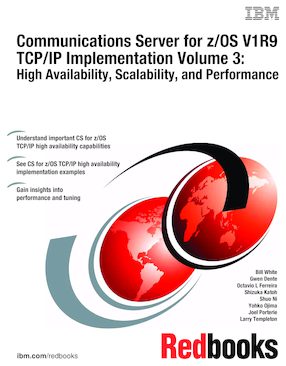Communications Server for z/OS V1R9 TCP/IP Implementation Volume 3: High Availability, Scalability, and Performance
An IBM Redbooks publication
Note: This is publication is now archived. For reference only.

Published on 24 April 2008
ISBN-10: 0738485179
ISBN-13: 9780738485171
IBM Form #: SG24-7534-00
Authors: Bill White, Gwen Dente, Octavio L Ferreira, Shizuka Katoh, Shuo Ni, Yohko Ojima, Joel Porterie and Larry Templeton
This Communications Server (CS) for z/OS TCP/IP Implementation series provides easy-to-understand, step-by-step guidance on enabling the most commonly used and important functions of CS for z/OS TCP/IP.
In this IBM Redbooks publication we begin with a discussion of Virtual IP Addressing (VIPA), a TCP/IP high-availability approach introduced by the z/OS Communications Server, both with and without using a dynamic routing protocol. Then we discuss a number of different workload balancing approaches that can be used with the z/OS Communications Server. Finally, we explain the optimized Sysplex Distributor intra-sysplex load balancing. This function is an improved multitier application support using optimized local connections together with weight values from extended WLM interfaces.
For more specific information on CS for z/OS base functions, standard applications, and security, refer to the other volumes in the series. These are:
- Communications Server for z/OS V1R9 TCP/IP Implementation Volume 1: Base Functions, Connectivity, and Routing, SG24-7532
- Communications Server for z/OS V1R9 TCP/IP Implementation Volume 2: Standard Applications6 Font, SG24-7533
- Communications Server for z/OS V1R9 TCP/IP Implementation Volume 4: Security and Policy-Based Networking, SG24-7535
Chapter 1. Introduction to CS for z/OS high availability technologies
Chapter 2. Virtual IP Addressing
Chapter 3. VIPA without dynamic routing
Chapter 4. VIPA with dynamic routing
Chapter 5. Internal application workload balancing
Chapter 6. External application workload balancing
Chapter 7. Intra-sysplex workload balancing
Chapter 8. Performance and tuning
Appendix A. Our implementation environment